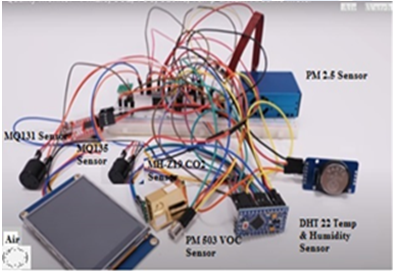Air Watch: An Ample Design of Indoor Air Quality Monitoring System
Main Article Content
Abstract
The environment is getting contaminated drastically by introducing harmful materials into the atmosphere through the excessive activities of human in adding comfort and luxurious style in their living. The pollutant level in air has high impact of healthiness of the person inhaling it. Air not outside as well indoor is infected by various hazardous particles and gases. To assess the air quality in the particular environment, it stimulates the need to monitor the hazardous elements listed. The internet of things (IoT) and artificial intelligence (AI) became the part of human life by adding smartness in their daily routines from facilitating control over appliances to own health factor as well automate operations. The primary objective of the effort is to identify the gases that cause air pollution, measure the air quality, and assess the level of pollution so that we can determine which gases cause pollution and at what place is the air being impacted. An IoT based indoor air quality monitoring system is built through incorporating carbon monoxide (CO), carbon dioxide (CO2), Ozone (O3), particulate matters (PM) and volatile organic components (VOC) sensors into Arduino board. The design ensures a complete air monitor, extends reliable service at low cost. A rule based system is developed to automate events upon the estimated air quality index (AQI) out of the sensory circuit.
Article Details
References
K. A. Kulkarni and M. S. Zambare, “The impact study of house plants in purification of environment using wireless sensor network”, Wireless Sensor Network, vol.10, no.03, pp.59–69, 2018.
Environmental Protection Agency (EPA), “Buildings and Their Impact on the Environment: A Statistical Summary”, Environmental Protection Agency Green Building Workgroup: Washington, DC, USA, 2009. Available online: http://www.epa.gov/greenbuilding/pubs/gbstatpdf (revised on 22 April 2009).
R. M. Reffat and E. L. Harkness, “Environmental comfort criteria: Weighting and integration”, J. Perform. Constr. Facil., vol.15, pp. 104–108, 2001.
S. Batterman and H. Burge, “HVAC systems as emission sources affecting indoor air quality: A critical review”, HVAC&R Res., vol. 1, pp. 61–78, 1995.
World Health Organization (WHO), “Ambient air pollution facts”, Available online: https://www.who.int/news-room/fact-sheets/detail/household-air-pollution-and-health (Accessed on 19 December 2022)
B. C. Singer and W. W. Delp, “Response of consumer and research grade indoor air quality monitors to residential sources of fine particles”, Indoor Air, Vol.28, pp. 624-639, 2019.
Marco Gola, Gaetano Settimo and Stefano Capolongo, “Indoor Air Quality in Inpatient Environments: A Systematic Review on Factors that Influence Chemical Pollution in Inpatient Wards”, Journal of Healthcare Engineering, vol.2019, pp. 1-20, 2019.
Gonçalo Marques, Jagriti Saini, Maitreyee Dutta, Pradeep Kumar Singh and Wei-Chiang Hong, “Indoor Air Quality Monitoring Systems Based on Internet of Things: A Systematic Review”, International Journal of Environmental Research and Public Health, Vol.17, No.4942, pp. 1-21, 2020.
James Heydon and Rohit Chakraborty, “Can portable air quality monitors protect children from air pollution on the school run? An exploratory study”, Environ Monit Assess, vol.192, no.195, pp. 1-16, 2020.
Jagriti Saini, Maitreyee Dutta and Gonçalo Marques, “A comprehensive review on indoor air quality monitoring systems for enhanced public health”, Sustainable Environment Research, vol. 30. no.6, pp. 1-12, 2020.
A. Rackes, T. Ben-David and M. S. Waring, “Sensor networks for routine indoor air quality monitoring in buildings: impacts of placement, accuracy, and number of sensors”, Science and Technology for the Built Environment, vol.24, no.2, pp.188–197, 2018.
Devahema , P., V. , Sai Surya Vamsi , Archit Garg, Abhinav Anand and Desu Rajasekhar Gupta, “IOT based Air Pollution Monitoring System”, Journal of Network Communications and Emerging Technologies (JNCET), vol.8, no. 4, pp. 100-103, 2018.
Harsh N. Shah, Zishan Khan, Abbas Ali Merchant, Moin Moghal, Aamir Shaikh and Priti Rane, “IOT Based Air Pollution Monitoring System”, International Journal of Scientific & Engineering Research, vol.9, no. 2, pp. 62-66, 2018.
Zheng Kan, Shaohang Zhao, Zhe Yang, Xiong Xiong and Wei Xiang, "Design and implementation of LPWA-based air quality monitoring system", IEEE Access, vol. 4, pp. 3238- 3245, 2016.
K. Okokpujie, E. Noma-Osaghae, O. Modupe, S. John and O. Oluwatosin, “A smart air pollution monitoring system”, International Journal of Civil Engineering and Technology, vol.9, pp.799–809, 2018.
G. Rout, S. Karuturi and T. N. Padmini, “Pollution monitoring system using IoT”, ARPN Journal of Engineering and Applied Sciences, vol.13, pp.2116–2123, 2018.
B. C. Kavitha, D. Jose and R. Vallikannu, “IoT based pollution monitoring system using raspberry–PI”, International Journal of Pure and Applied Mathematics, vol.118, 2018.
Phala, Kgoputjo Simon Elvis, Anuj Kumar, and Gerhard P. Hancke. "Air quality monitoring system based on ISO/IEC/IEEE 21451 standards", IEEE Sensors Journal, vol. 16, no. 12, pp. 5037-5045, 2016.
M. Tastan and H. Gokozan, “Real-time monitoring of indoor air quality with internet of things-based E-nose”, Applied Sciences, vol.9, no.16, article3435, 2019.
Martin M. Soto-Cordova, Martha Medina-De-La-Cruz and Anderson Mujaico-Mariano, “An IoT based Urban Areas Air Quality Monitoring Prototype”, International Journal of Advanced Computer Science and Applications, vol. 11, no. 9, pp. 711-716, 2020.
G. Marques, C. Ferreira and R. Pitarma, “Indoor air quality assessment using a CO2 monitoring system based on Internet of Things”, Journal of Medical Systems, vol.43, no.3, pp.67, 2019.
Jun Ho Jo, Byung Wan Jo, Jung Hoon Kim, SungJun Kim and Woon Yong Han, “Development of an IoT-Based Indoor Air Quality Monitoring Platform”, Journal of Sensors-Hindawi, vol.2020, pp. 1-14, 2020.
Ghosal, P. ., S. Himavathi, S. Himavathi, & E. Srinivasan. (2023). Improved Method for Motion Artifact Reduction from Finger Photoplethysmogram Signal. International Journal of Intelligent Systems and Applications in Engineering, 11(1), 190–194. Retrieved from https://ijisae.org/index.php/IJISAE/article/view/2458.
Ajitesh Kumar, Mona Kumari and Harsha Gupta, “Design and Analysis of IoT based Air Quality Monitoring System”, In Proc. of 2020 International Conference on Power Electronics & IoT Applications in Renewable Energy and its Control (PARC) GLA University, Mathura, UP, India, pp. 242-245, 2020.
Yuxuan Yang, “IoT-based air pollution monitoring system”, Highlights in Science, Engineering and Technology, vol. 17, pp. 299-307, 2022.
N. Chaitra S. Bhavana, D. N. Vilas Reddy and A. S. Nikhil, “Iot Based Air Quality Monitoring System”, European Journal of Molecular & Clinical Medicine ,vol. 7, no. 8, pp. 3034-3040, 2020.
C. Stergiou, K. Psannis, B. Kim and B. Gupta, “Secure integration of IoT and cloud computing”, Future Generation Computer Systems, vol.78, pp.964–975, 2018.
Brainvendra Widi Dionovaa,, M.N. Mohammedb, S. Al-Zubaidic and Eddy Yusufd, “Environment indoor air quality assessment using fuzzy inference system” ICT Express, vol. 6, pp. 185-194, 2020.
Shaharil Mad Saad, Allan Melvin Andrew, Ali Yeon Md Shakaff , Mohd Azuwan Mat Dzahir, Mohamed Hussein, Maziah Mohamad and Zair Asrar Ahmad, “Pollutant Recognition Based on Supervised Machine Learning for Indoor Air Quality Monitoring Systems”, Applied Sciences, vol. 7, no. 823, pp. 1–21, 2017.
Chris C. Lima, Ho Kimb , M.J. Ruzmyn Vilcassima, George D. Thurstona, Terry Gordona, Lung-Chi Chena, Kiyoung Leeb Michael Heimbinderc and Sun-Young Kim, “Mapping urban air quality using mobile sampling with low-cost sensors and machine learning in Seoul, South Korea”, Environment International, vol.131, no,105022, pp. 1-10, 2019.

